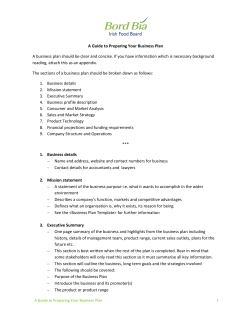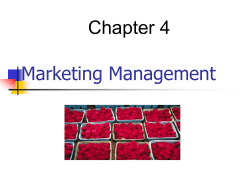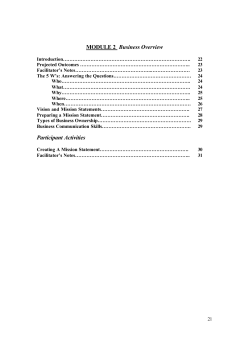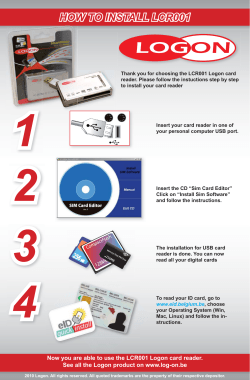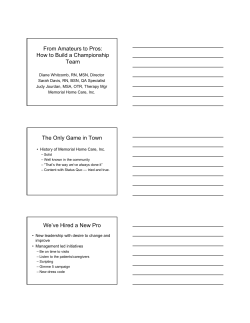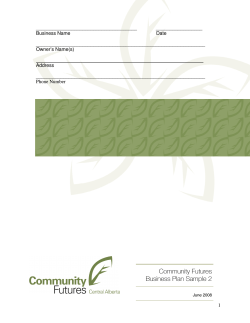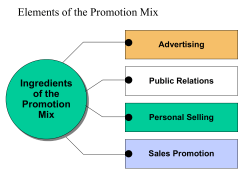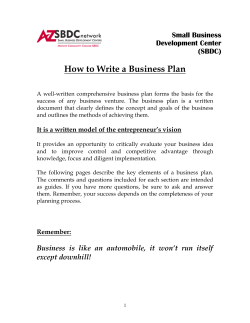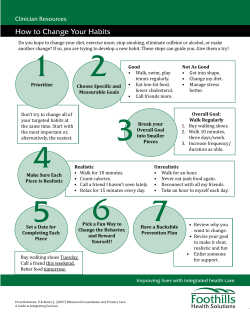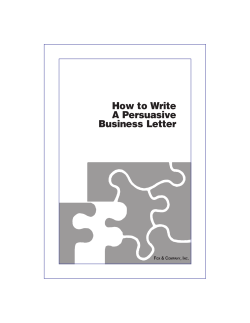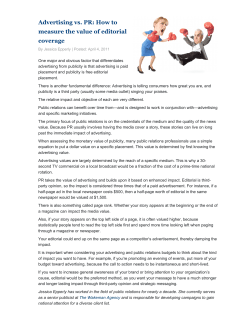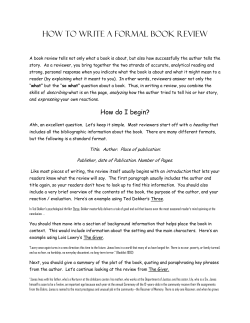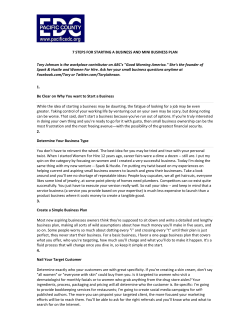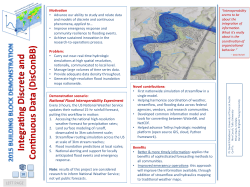
Guidelines on Prepar Guidelines on Preparing a Business Plan
Guidelines on Preparing Preparing a Business Plan Business planning is fundamental to success in business. It is the key to getting things done and making things happen. The finished business plan becomes an operating tool that will help you to manage your business and work towards its success. Why prepare a business plan? A good, well-organised business plan will tell you if your idea makes sense. It is also the first marketing aid that you will use to persuade interested third parties such as investors, banks and the State agencies of the potential viability of the business. Useful Tips Things to bear in mind when writing the plan are as follows:- Own the content By preparing the plan yourself you will “own the content” and identify problems that are likely to arise. This will allow consideration of how you will solve them. If you have a partner in the business it is a good idea for you to work through the plan together. This will give you an insight into how you will work together in the business. Ensure the plan fits you If the small business is an extension of the owner manager then the plan must capture your personal motivation and direction. There is no use preparing a plan that is in direct conflict with what you really want from business or life over the coming years. Not everything has to be committed to paper. It is more important that you have thought the issues through and that you and your family are comfortable with the direction, structure and pace of growth planned for the business. Be realistic - err on the side of caution Be careful about producing figures or projections that are clearly at odds with the experience of others in the same business. If you present a case which shows a net profit of 10% of sales when the average in the industry is 4%-6% you will have to be able to show how you are going to achieve the difference. Remember the importance of realism. Over optimistic forecasts will put your investment at risk. - It will act as a map for the business It will assist you with management control. It will help you brief key employees. It will help you secure finance. identifiable goals, you will be able to see clearly the difference between what is actually happening against what you had planned would happen. This gives you control over the situation and enables you to decide more clearly the corrective action needed to put yourself back on course. Avoid padding Keep the document brief and to the point. If it is a simple business the plan should reflect this. If it is a complex business you may need to prepare a more elaborate, but equally realistic document. Presentation The plan should be typed and bound with a table of contents. It should be written to communicate rather than to impress, easy and simple to follow, with accurate text and figures. The Structure of the Business Plan A good business plan will contain the following sections:- Executive Summary If the plan is to provide you with a direction then your objectives and goals should be clearly stated, realistic and attainable. The objectives as set out in the plan must be clear to the reader. They are in effect a measure of your ability to deliver as a manager. The executive summary is an overall view of your business and it’s potential. It is a very important part of the plan. Many readers of business plans tend to skim through sections which are not of particular interest to them and focus only on the areas in which they have specialist knowledge. They will, however, always read the executive summary. It is essential, therefore, that you present the essence of your plan in a few short paragraphs at the start so that, even if much of it goes unread, the thrust of what you intend to do, your objectives and the way you are going to achieve them will be clear to the reader. It is important to highlight the ways in which the plan meets the assessment criteria of the reader. Nothing will go exactly as planned Background and Description of the Business During the process of starting up and operating your business you will encounter various problems which cannot be foreseen. If you have a documented plan with In this section you should set out the rationale behind the business. If the plan is for an existing business this section will provide a brief synopsis of the business Be clear in your objectives Guidelines on Preparing a Business Plan idelines on Preparing a Business Plan history to date. It is important to present the reader with a clear, unambiguous statement of what you propose to make or sell and why you perceive this product or service to be appropriate at this time. Management and Organisational Structure In this section you should detail how your company will be organised and managed. Clearly link the people in the business to the objectives set out in the plan. If the business is going to be initially organised and run by you as a sole trader, state this and provide a brief resume which summaries your relevant experience and establishes your suitability for the business. If you are planning to set up a larger company with a management team you must provide much greater detail of the organisational structure of the company. This should include information about professional advisers and/or technical experts you have retained to help you overcome particular weaknesses and provide you with on-going advice and assistance as you develop the business. Market Research and the Marketing Plan - is there a market for the product or service? You may have collected your information for this section in a variety of ways. It is possible that you have obtained advance purchase commitments from buyers. You could be a retailer who has based your market research on a study of traffic and pedestrian flows, activity patterns and competition. If you are a painter decorator you might have piloted the service for a number of months and now have a good basis for setting a realistic sales target. Whatever your business or method of researching it, you should now be in a position to answer the following questions. Demand - this includes both the need for your product or service and the extent of this need. Evidence of the need must be clearly shown. You should also indicate whether your product or service is a repeat item which will be purchased again and again by your customers or whether sales will be once-off. Indicate if the product or service is likely to be in demand over a long period of time or if it is a short lived fad. Target market - this is the market you intend to seek for your product or service. The larger your potential market the better but, more importantly, you need to know if it is growing, levelling out or declining. Competition - Regardless of the product or service that you offer you will always have competition. Reaction by your competitors may alter some of the assumptions you have made in relation to price, service, promotion or advertising. Product Range Detail the product range that will be introduced. It is important to highlight the Unique Selling Points of your product or service. It may be a totally unique product for instance; it could be a service which includes specialised knowledge; it could be very keen pricing. Pricing Strategy Pricing has to be carefully considered because the price you select has an important effect on the image of the product or service you are offering. If you choose one price it positions your product for one market. At a lower price or a higher price the same product would be perceived entirely differently. Channels of Distribution You must decide the geographic area in which you will market your product or service and whether it is better to sell directly yourself, go to retail outlets or use wholesalers. You can sometimes beat the competition or generate much more profit by using a unique distribution system. How will the Product or Service be promoted? The promotion of your business is divided between advertising, personal selling and sales promotion. Advertising: Specify in the plan the papers, magazines, directories such as Golden Pages, radio or TV that you have identified as most appropriate for targeting your customers. The advertising message should be planned carefully and repeated consistently for optimum impact. Personal Selling: A personal selling strategy is particularly effective and necessary when a >> product must be explained in order that it is fully understood by the potential customer. Sales Promotion: Sales promotion includes such schemes as free samples, contests and introductory offers. It is very important to link promotion to your cash flow. Sales Management instead the type and function of the equipment you are buying so that the reader will have a clear image of your operational environment. Describe the manufacturing process to be used and, if appropriate, explain how your principal competitors go about their manufacturing. Include the following information. Who will conduct the selling for your business and are they professionally trained to sell? • A description of the equipment that will be required and its capabilities. What selling methods will you employ, for example telephone selling, cold calling, following up leads from mailshots, advertising etc? • A drawing of the layout of your production unit showing the path of materials and finished goods. What sales volume and activity targets, such as calls per day etc, have you set for each salesperson or selling method? • Raw material sourcing - list your principal suppliers, the terms of trade and any possible vulnerability in this area. How long is the sales process from the customer becoming aware of your product or service to making the buying decision, receiving the product or service and finally paying for it? • Employment - the proposed number of employees if any and the initial training to be provided. What procedures do you have for handling customer complaints? Will you make the product yourself or buy in either ready to sell or as components for assembly? Sales Forecasts You will need to prepare a sales forecast on which you can base monthly cash flows and budgets. While it is not always easy for a start- up company to accurately project sales you should use your market research to give as clear a picture as possible. The realism of the assumptions behind your sales forecasts is one of the most critical factors in the success or failure of the venture. Make sure you give sufficient time to this. The Operations’ Plan - how will you guarantee product/service quality? “Operations” is the general name given to all the activities required to implement strategy. Once you have decided what to sell, to whom and at what price you may still need to find someone to make your product, sell it and deliver it. Do not confine this section of your plan to a list of the equipment you are proposing to purchase. Describe • Procedures for monitoring and controlling quality. The Financial Plan - is this business viable? This section of the business plan will provide the reader with the following information: • the total funding required to start the business and the sources; • a detailed set of cash flow forecasts for the business; • a projected profit and loss account for the business; • details on the costing and pricing of your product or service. Business Plan Template Visit www.localenterprise.ie/southcork for access to a business plan template.
© Copyright 2025
